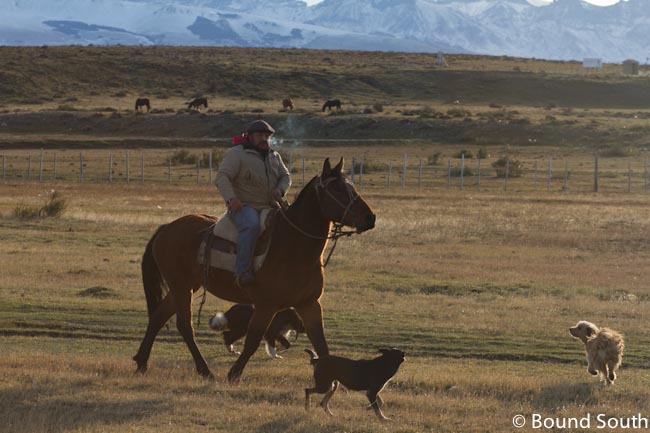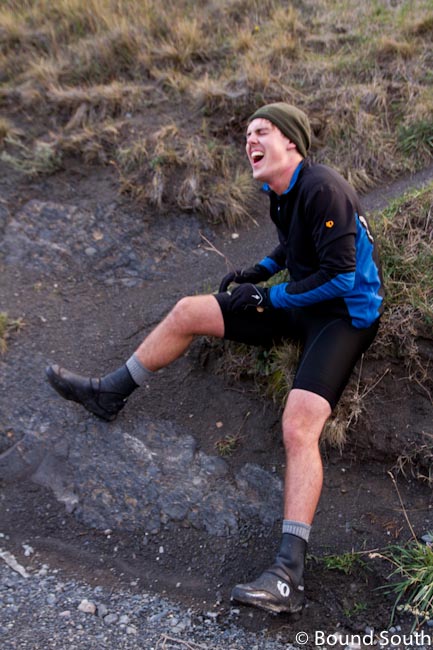Rambling_through_the Palouse of Eastern Washington, many months ago, we came up with a maxim that has served us well to this day. “When in doubt, choose adventure.” Noble in its intention, “choosing adventure” is meant to ensure that we don’t shy away from the paths less traveled. They may be more dangerous or uncertain or difficult. Adventure is a big part of Bound South. In practice, however, this maxim is most often leveraged ex post to justify a poor decision by yours truly.

A reminder of hard work.

Our first day in Ecuador was a rainy and cold one.

We stumbled upon this school that night, where we took shelter.

A typical lunch in Colombia and Ecuador. For $2 or less, you can get a hearty meat and vegetable soup, an enormous plate of beans, rice, chicken, and potatoes, and a cold cup of juice. We love it.

Cycling is celebrated in Colombia and Ecuador. Road signs and statues are common.
Here is an example from our past days in Ecuador: we were riding down the Pan-American highway. The road is spectacular, smooth, and mountainous. I hear about “the old highway from Salinas” and convince Nathan and David to explore it with me. The result? Epic, muddy dirt roads, stream crossings, five-way-dirt-intersections-with-no-signs, impossibly steep cobblestone climbs, and lots of getting lost in the country. We finally wound our way back to the Pana, exhausted and dirty. At least we traveled southwards, right? We press on, “adventure” the word begrudgingly gritted between our teeth.

The old "highway" from Salinas.

This tarantula (or rather the sight of him) on the Salinas road nearly knocked me off my bike.

Old roads are the best roads.
Thankfully it doesn’t always work out that way. That’s what real adventure is about after all; it is not a steady and predictable set of wonderful experiences and surmountable challenges. As Robin Hanson writes, “This has a big lesson for those who like to think of their real life as a grand adventure: relative to fiction, real grand adventures tend to have fewer guides, and more randomness in success. Real adventurers must accept huge throws of the dice; even if you do most everything right, most likely some other lucky punk will get most of the praise.” They must “learn to see the glorious nobility of those who try well yet fail.” That’s real adventure; simultaneously sobering and satisfying.

Entering one of many tunnels on El Chaquinan.

Leaving the rain, complete darkness engulfed us in most tunnels. Headlights were a necessity.

Steep and muddy single-track called for teamwork.

Mud was inescapable and a bit of fun.

Isaiah functioned as Nathan and David's rear brake for this extremely slippery downhill.

The riding was unforgettable.
Sometimes adventure works out and it makes all of the hapless searching and uncertainty worth its while. We found an old decommissioned railroad line outside of Quito that had devolved (evolved?) into unkempt dirt singletrack, winding its way through countless canyons and dark tunnels. Locals call it El Chaquinan and were shocked to see gringos attempting its passage by bicycle. It wasn’t particularly difficult riding, safe for the parts where we had to scale muddy walls by pushing the bikes, or where my tires washed out on some old rails and sent me diving over the bars. It was fun, like the first time you rode your bicycle through the rain and mud as a kid. It was the kind of riding I will remember for the rest of my life. The annual Carnival celebrations in Ecuador helped us clean off the mud; so many children had squirt guns to do battle with our water bottles. In the end, we arrived in Tumbaco muddy, tired, and excited for the time to rest with our fantastic hosts. Teachers at the British School near Quito, the Tober family hosted us and fed us and let us be a part of their family and community at the British School. The adventure continues now south of Quito as we ride quickly into Peru. Spending time with the Tober-Zambrano family made us all miss our own family and home. When you think about it, family is a real adventure with great reward and few guides. Our sights are set on that and so much more as we continue southwards on our bicycles.

Camelback's high performance jet valve bottle technology proved to be unbeatable.

We spotted this rider from the railroad line high above in the canyon.

We called this bamboo shack home for a few days while we stayed with the Tober-Zambrano family.

During our presentation at the British School, many questions were asked.

Steve lets his daughter, Carla, give Angus a try.

Like their parents, Steve and Maria's children were bicycle fanatics.

Ramone dizzies David with a few roundabout laps at center court.

Carla didn't hesitate to show off her cycling prowess either. In fact, she was very clear about how she was both stronger and faster than David on the swings and on her bicycle.

The end of a hard day's work at the British School









































































































